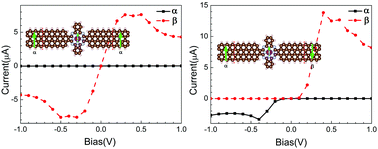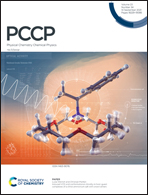A first-principles study of phthalocyanine-based multifunctional spintronic molecular devices†
Abstract
In this study, using the first-principles method, we theoretically investigated the spin-dependent transport properties of a phthalocyanine (Pc) molecule, which is sandwiched between two zigzag-edged graphene nanoribbon (zGNR) electrodes. Owing to the spatial symmetry of the Pc molecule and spin splitting of zGNRs around Fermi energy, perfect spin filtering behavior is observed in designed molecular junctions. Meanwhile, the spin of electrons allowed through the device is right opposite to the spin polarization of zGNR electrodes. Further studies show that the spin filtering performance can be largely modulated by insetting different transition metal atoms (TM = Mn or Cr) into the central Pc molecule, and changing the spin-polarized direction of the TM atom leads to the spin filtering direction inversion. More intriguingly, the antiparallel magnetic configuration of two zGNR electrodes gives rise to the control of the conducting channel by bias polarization, which eventually leads to remarkable spin rectifying and giant magnetoresistance behaviors in transition metal phthalocyanine (TMPc) molecular junctions. The corresponding mechanisms are revealed by an analysis of spin-resolved transmission spectra, molecular projected self-consistent Hamiltonian and a projected density of states. These results are helpful in the design of TMPc-based multifunctional spin molecular devices.



 Please wait while we load your content...
Please wait while we load your content...